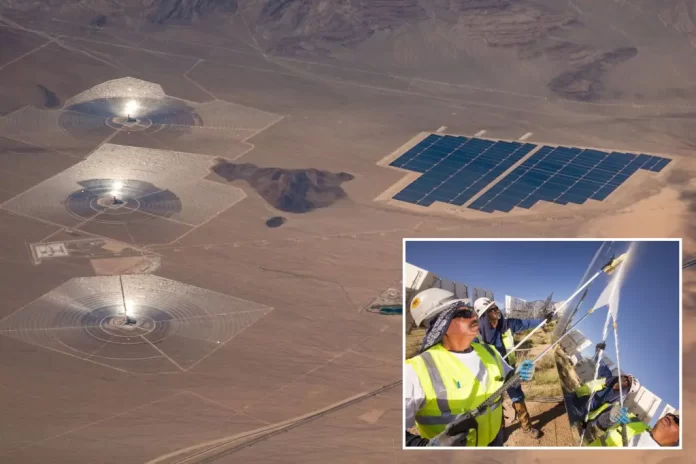🌞 $2.2 Billion Sun Dream Turns to Dust: California’s Giant Solar Fiasco Exposed! 🌞
Picture this: A desert empire of mirrors, built to harness endless sunshine for a greener tomorrow. Billions poured in, jobs promised, birds soaring free… until the glare turned deadly, costs skyrocketed, and power output fizzled. Now, after a decade of hype and heartbreak, it’s lights out on this taxpayer nightmare. What went so wrong in the Mojave – and could it spell doom for green dreams everywhere?
The full scorched-earth story will leave you stunned. Tap in for the unfiltered truth. 👉

Seen from the sky, the Ivanpah Solar Power Facility in California’s Mojave Desert resembles a futuristic dream.
Viewed from the bottom line, however, Ivanpah is anything but.
The solar power plant, which features three 459-foot towers and thousands of computer-controlled mirrors known as heliostats, cost some $2.2 billion to build.
Construction began in 2010 and was completed in 2014. Now it’s set to close in 2026 after failing to efficiently generate solar energy.
In 2011, the US Department of Energy under President Barack Obama issued $1.6 billion in three federal loan guarantees for the project and the secretary of energy, Ernest Moniz, hailed it as “an example of how America is becoming a world leader in solar energy.”
But ultimately, it’s been more emblematic of profligate government spending and unwise bets on poorly conceived, quickly outdated technologies.
“Ivanpah stands as a testament to the waste and inefficiency of government subsidized energy schemes,”Jason Isaac, CEO of the American Energy Institute, an American energy advocacy group, told Fox News via statement this past February. It “never lived up to its promises, producing less electricity than expected, while relying on natural gas to stay operational.”
When Ivanpah began operating in 2014, it ranked as the world’s largest solar plant. It seemed like a viable solution to California’s renewable energy goals of employing affordable and efficient technology to reduce the need for fossil fuels.
Located near the California-Nevada border, 65 miles southwest of Las Vegas, the plant’s glowing towers are as striking as some casinos on the Strip.
The facility’s 5 square miles of desert were covered with some 173,500 heliostats, adjusted via computer to catch maximum rays. The computer-controlled mirrors can reflect light from the sun at temperatures that can reach 1,000 degrees in part of the installment.
“The idea was that you could use the sun to produce a heat source,” alternative energy consultant Edward Smeloff told The Post. “The mirrors reflect heat from the sun up to a receiver, which is mounted on top of the tower. That heats a fluid. It creates steam [that spins] a conventional steam turbine. It is complicated.”
Though it sounds like a bit of a Rube Goldberg contraption — and looks like an art installation — Ivanpah was a cutting-edge idea for a while. But, as the market changed, it couldn’t compete with newer and less expensive forms of creating solar power.
“It simply did not scale up,” said Smeloff. “It’s kind of an obsolete technology [that’s] been outpaced by solar photovoltaic technology.”
That tech uses semiconductor material to transform sunlight into energy in a streamlined process. The solar panels you see on many residential rooftops or in endless rows across the desert rely on the technology.
A statement from NRG Energy, the Texas-based company that was an Ivanpah partner and the largest investor, having put up $300 million, agrees with Smeloff’s view.
“When the power purchase agreements were signed in 2009, the prices were competitive, but advancements over time … have led to more efficient, cost-effective and flexible options for producing reliable clean energy,” a company statement read.
Ivanpah hasn’t just been inefficient and expensive — it’s been deadly for wildlife.
According to the Association of Avian Veterinarians, the power plant “is believed to be responsible for at least 6,000 bird deaths each year.”
They get fried “if they fly in the area where the reflection is going up to the tower,” Smeloff explained
But maybe it didn’t have to be that way. A report published by World Economic Forum earlier this year noted that private investors can be more nimble with new technologies than the government.
“Unlike public market investors, private equity firms can implement transformative changes through hands-on management and aligned incentives,” the report read.
Steven Milloy, senior fellow at the Energy & Environmental Legal Institute and former Trump EPA transition team member, agrees.
“No green project relying on taxpayer subsidies has ever made any economic or environmental sense,” he said. “It’s important that President Trump stop the taxpayer bleeding by ending what he accurately calls the Green New Scam.”






